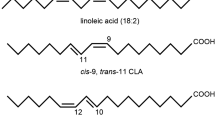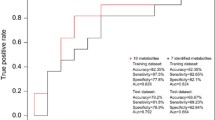Abstract
Purpose
Over the past few decades, docosahexaenoic acid (DHA) has gained special attention for management of cholesterol-associated metabolic disorders and neurodegenerative diseases such as Alzheimer’s disease (AD) owing to its neuroprotective, anti-inflammatory and hypolipidemic properties. Several epidemiological studies have reported the effect of DHA in reducing the risk of developing AD by lowering cholesterol. Hypercholesterolemia is a pro-amyloidogenic factor influencing the enzymatic processing of amyloid-β precursor protein (AβPP) to toxic β-amyloid. However, the mechanism by which DHA modulates the cholesterol pathway has not been established. Thus, the objective of this study was to investigate the mechanism of regulation of cholesterol metabolism by DHA in an AβPP695 overexpressing AD cell model.
Methods
A gas chromatography/mass spectrometry method was developed and validated for the targeted profiling of 11 cholesterol metabolites in DHA-treated Chinese hamster ovary wild-type (CHO-wt) and AβPP695 overexpressing (CHO-AβPP695) cells. The differential metabolite profiles between DHA- and vehicle-treated groups were further analyzed using fold change values of the ratio of concentration of metabolites in CHO-AβPP695 to CHO-wt cells. Effect of DHA on key rate-limiting enzymatic activities within the cholesterol pathway was established using biochemical assays.
Results
Our results showed that DHA reduced the levels of key cholesterol anabolites and catabolites in CHO-AβPP695 cells as compared to CHO-wt cells. Further enzymatic studies revealed that the cholesterol-lowering effect of DHA was mediated by regulating HMG-CoA reductase and squalene epoxidase enzyme activities.
Conclusion
We demonstrate for the first time the dual effects of DHA in inhibiting HMG-CoA reductase and squalene epoxidase and modulating the sterol biosynthesis axis of the cholesterol pathway in AβPP695 overexpressing AD. Our novel findings underscore the potential of DHA as a multi-target hypocholesterolemic agent for the prophylaxis of AD and other cholesterol-associated diseases.




Similar content being viewed by others
References
Muskiet FAJ, van Goor SA, Kuipers RS, Velzing-Aarts FV, Smit EN, Bouwstra H, Janneke Dijck-Brouwer DA, Rudy Boersma E, Hadders-Algra M (2006) Long-chain polyunsaturated fatty acids in maternal and infant nutrition. Prostaglandins Leukot Essent Fatty Acids 75(3):135–144
Bazan NG, Molina MF, Gordon WC (2011) Docosahexaenoic acid signalolipidomics in nutrition: significance in aging, neuroinflammation, macular degeneration, Alzheimer’s, and other neurodegenerative diseases. Annu Rev Nutr 31:321–351
Jacobson TA, Glickstein SB, Rowe JD, Soni PN (2012) Effects of eicosapentaenoic acid and docosahexaenoic acid on low-density lipoprotein cholesterol and other lipids: a review. J Clin Lipidol 6(1):5–18
Holub BJ (2009) Docosahexaenoic acid (DHA) and cardiovascular disease risk factors. Prostaglandins Leukot Essent Fatty Acids 81(2–3):199–204
Morris M, Evans DA, Bienias JL et al (2003) Consumption of fish and n-3 fatty acids and risk of incident Alzheimer disease. Arch Neurol 60(7):940–946
Farooqui AA, Ong WY, Horrocks LA, Chen P, Farooqui T (2007) Comparison of biochemical effects of statins and fish oil in brain: the battle of the titans. Brain Res Rev 56(2):443–471
Sparks DL, Scheff SW, Hunsaker JC III, Liu H, Landers T, Gross DR (1994) Induction of Alzheimer-like β-amyloid immunoreactivity in the brains of rabbits with dietary cholesterol. Exp Neurol 126(1):88–94
Corder EH, Saunders AM, Strittmatter WJ, Schmechel DE, Gaskell PC, Small GW, Roses AD, Haines JL, Pericak-Vance MA (1993) Gene dose of apolipoprotein E type 4 allele and the risk of Alzheimer’s disease in late onset families. Science 261(5123):921–923
Notkola IL, Sulkava R, Pekkanen J, Erkinjuntti T, Ehnholm C, Kivinen P, Tuomilehto J, Nissinen A (1998) Serum total cholesterol, apolipoprotein E epsilon 4 allele, and Alzheimer’s disease. Neuroepidemiology 17(1):14–20
Kivipelto M, Helkala E-L, Laakso MP, Hänninen T, Hallikainen M, Alhainen K, Soininen H, Tuomilehto J, Nissinen A (2001) Midlife vascular risk factors and Alzheimer’s disease in later life: longitudinal, population based study. Br Med J 322(7300):1447–1451. doi:10.1136/bmj.322.7300.1447
Barrett PJ, Song Y, Horn WDV, Hustedt EJ, Schafer JM, Hadziselimovic A, Beel AJ, Sanders CR (2012) The amyloid precursor protein has a flexible transmembrane domain and binds cholesterol. Science 336(6085):1168–1171
Silva T, Teixeira J, Remiao F, Borges F (2013) Alzheimer’s disease, cholesterol, and statins: the junctions of important metabolic pathways. Angew Chem Int Ed Engl 52(4):1110–1121
Lutjohann D, Papassotiropoulos A, Bjorkhem I, Locatelli S, Bagli M, Oehring RD, Schlegel U, Jessen F, Rao ML, von Bergmann K, Heun R (2000) Plasma 24S-hydroxycholesterol (cerebrosterol) is increased in Alzheimer and vascular demented patients. J Lipid Res 41(2):195–198
Schonknecht P, Lutjohann D, Pantel J, Bardenheuer H, Hartmann T, von Bergmann K, Beyreuther K, Schroder J (2002) Cerebrospinal fluid 24S-hydroxycholesterol is increased in patients with Alzheimer’s disease compared to healthy controls. Neurosci Lett 324(1):83–85
Grimm MO, Kuchenbecker J, Grosgen S, Burg VK, Hundsdorfer B, Rothhaar TL, Friess P, de Wilde MC, Broersen LM, Penke B, Peter M, Vigh L, Grimm HS, Hartmann T (2011) Docosahexaenoic acid reduces amyloid β production via multiple pleiotropic mechanisms. J Biol Chem 286(16):14028–14039
Nicholson JK, Lindon JC, Holmes E (1999) ‘Metabonomics’: understanding the metabolic responses of living systems to pathophysiological stimuli via multivariate statistical analysis of biological NMR spectroscopic data. Xenobiotica 29(11):1181–1189
Greenberg N, Grassano A, Thambisetty M, Lovestone S, Legido-Quigley C (2009) A proposed metabolic strategy for monitoring disease progression in Alzheimer’s disease. Electrophoresis 30(7):1235–1239
Motsinger-Reif A, Zhu H, Kling M, Matson W, Sharma S, Fiehn O, Reif D, Appleby D, Doraiswamy PM, Trojanowski J, Kaddurah-Daouk R, Arnold S (2013) Comparing metabolomic and pathologic biomarkers alone and in combination for discriminating Alzheimer’s disease from normal cognitive aging. Acta Neuropathol Commun 1(1):28
Oresic M, Hyotylainen T, Herukka SK, Sysi-Aho M, Mattila I, Seppanan-Laakso T, Julkunen V, Gopalacharyulu PV, Hallikainen M, Koikkalainen J, Kivipelto M, Helisalmi S, Lotjonen J, Soininen H (2011) Metabolome in progression to Alzheimer’s disease. Trans Psychiatry 1:e57
Li NJ, Liu WT, Li W, Li SQ, Chen XH, Bi KS, He P (2010) Plasma metabolic profiling of Alzheimer’s disease by liquid chromatography/mass spectrometry. Clin Biochem 43(12):992–997
Bahety P, Tan YM, Hong Y, Zhang L, Chan ECY, Ee P-LR (2014) Metabotyping of docosahexaenoic acid-treated Alzheimer’s disease cell model. PLoS One 9(2):e90123
Chang TY, Hasan MT, Chin J, Chang CC, Spillane DM, Chen J (1997) Chinese hamster ovary cell mutants affecting cholesterol metabolism. Curr Opin Lipidol 8(2):65–71
Christian AE, Haynes MP, Phillips MC, Rothblat GH (1997) Use of cyclodextrins for manipulating cellular cholesterol content. J Lipid Res 38(11):2264–2272
Lagace TA, Byers DM, Cook HW, Ridgway ND (1997) Altered regulation of cholesterol and cholesteryl ester synthesis in Chinese-hamster ovary cells overexpressing the oxysterol-binding protein is dependent on the pleckstrin homology domain. Biochem J 326(Pt 1):205–213
Leonard S, Sinensky M (1988) Somatic cell genetics and the study of cholesterol metabolism. Biochim Biophys Acta 947(1):101–112
Cadigan KM, Spillane DM, Chang TY (1990) Isolation and characterization of Chinese hamster ovary cell mutants defective in intracellular low density lipoprotein–cholesterol trafficking. J Cell Biol 110(2):295–308. doi:10.1083/jcb.110.2.295
Li S, Deng J, Hou H, Tian J, Giunta B, Wang Y, Sawmiller D, Smith A, Sanberg PR, Obregon D, Mori T, Tan J (2014) Specific antibody binding to the APP672-699 region shifts APP processing from [α]- to [β]-cleavage. Cell Death Dis 5:e1374
Ma QH, Futagawa T, Yang WL, Jiang XD, Zeng L, Takeda Y, Xu RX, Bagnard D, Schachner M, Furley AJ, Karagogeos D, Watanabe K, Dawe GS, Xiao ZC (2008) A TAG1-APP signalling pathway through Fe65 negatively modulates neurogenesis. Nat Cell Biol 10(3):283–294
Urano Y, Ochiai S, Noguchi N (2013) Suppression of amyloid-β production by 24S-hydroxycholesterol via inhibition of intracellular amyloid precursor protein trafficking. FASEB J 27(10):4305–4315
Huttunen HJ, Peach C, Bhattacharyya R, Barren C, Pettingell W, Hutter-Paier B, Windisch M, Berezovska O, Kovacs DM (2009) Inhibition of acyl-coenzyme A: cholesterol acyl transferase modulates amyloid precursor protein trafficking in the early secretory pathway. FASEB J 23(11):3819–3828
Acimovic J, Lovgren-Sandblom A, Monostory K, Rozman D, Golicnik M, Lutjohann D, Bjorkhem I (2009) Combined gas chromatographic/mass spectrometric analysis of cholesterol precursors and plant sterols in cultured cells. J Chromatogr B Anal Technol Biomed Life Sci 877(22):2081–2086
Axelson M, Larsson O (1996) 27-hydroxylated low density lipoprotein (LDL) cholesterol can be converted to 7α,27-dihydroxy-4-cholesten-3-one (cytosterone) before suppressing cholesterol production in normal human fibroblasts. Evidence that an altered metabolism of LDL cholesterol can underlie a defective feedback control in malignant cells. J Biol Chem 271(22):12724–12736
Le Fur Y, Maume G, Feuillat M, Maume BF (1999) Characterization by gas chromatography/mass spectrometry of sterols in Saccharomyces cerevisiae during autolysis. J Agric Food Chem 47(7):2860–2864
Wolf C, Chevy F, Pham J, Kolf-Clauw M, Citadelle D, Mulliez N, Roux C (1996) Changes in serum sterols of rats treated with 7-dehydrocholesterol-delta 7-reductase inhibitors: comparison to levels in humans with Smith–Lemli–Opitz syndrome. J Lipid Res 37(6):1325–1333
Grimm MOW, Zimmer VC, Lehmann J, Grimm HS, Hartmann T (2013) The impact of cholesterol, DHA, and sphingolipids on Alzheimer’s disease. BioMed Res Int 2013:814390
Hooff GP, Wood WG, Müller WE, Eckert GP (2010) Isoprenoids, small GTPases and Alzheimer’s disease. Biochim Biophys Acta 1801(8):896–905. doi:10.1016/j.bbalip.2010.03.014
Zhou Y, Su Y, Li B, Liu F, Ryder JW, Wu X, Gonzalez-DeWhitt PA, Gelfanova V, Hale JE, May PC, Paul SM, Ni B (2003) Nonsteroidal anti-inflammatory drugs can lower amyloidogenic Aβ42 by inhibiting Rho. Science 302(5648):1215–1217
Wood WG, Schroeder F, Igbavboa U, Avdulov NA, Chochina SV (2002) Brain membrane cholesterol domains, aging and amyloid β-peptides. Neurobiol Aging 23(5):685–694
Serrano-Pozo A, Vega GL, Lütjohann D, Locascio JJ, Tennis MK, Deng A, Atri A, Hyman BT, Irizarry MC, Growdon JH (2010) Effects of simvastatin on cholesterol metabolism and Alzheimer disease biomarkers. Alzheimer Dis Assoc Disord 24(3):220–226
Lindenthal B, Bertsch T, Fassbender K, Stroick M, Khl S, Ltjohann D, von Bergmann K (2002) Influence of simvastatin, pravastatin, and BM 15.766 on neutral sterols in liver and testis of guinea pigs. Metabolism 51(4):492–499
Kempen HJ, Glatz JF, Gevers Leuven JA, van der Voort HA, Katan MB (1988) Serum lathosterol concentration is an indicator of whole-body cholesterol synthesis in humans. J Lipid Res 29(9):1149–1155
Xu L, Korade Z, Rosado DA Jr, Mirnics K, Porter NA (2013) Metabolism of oxysterols derived from nonenzymatic oxidation of 7-dehydrocholesterol in cells. J Lipid Res 54(4):1135–1143
Herman GE (2003) Disorders of cholesterol biosynthesis: prototypic metabolic malformation syndromes. Hum Mol Genet 12(suppl 1):R75–R88. doi:10.1093/hmg/ddg072
Shafaati M, Marutle A, Pettersson H, Lovgren-Sandblom A, Olin M, Pikuleva I, Winblad B, Nordberg A, Bjorkhem I (2011) Marked accumulation of 27-hydroxycholesterol in the brains of Alzheimer’s patients with the Swedish APP 670/671 mutation. J Lipid Res 52(5):1004–1010
Prasanthi J, Huls A, Thomasson S, Thompson A, Schommer E, Ghribi O (2009) Differential effects of 24-hydroxycholesterol and 27-hydroxycholesterol on β-amyloid precursor protein levels and processing in human neuroblastoma SH-SY5Y cells. Mol Neurodegener 4(1):1
Karanth S, Tran VM, Kuberan B, Schlegel A (2013) Polyunsaturated fatty acyl-coenzyme As are inhibitors of cholesterol biosynthesis in zebrafish and mice. Dis Model Mech 6(6):1365–1377
Gelsomino G, Corsetto PA, Campia I, Montorfano G, Kopecka J, Castella B, Gazzano E, Ghigo D, Rizzo AM, Riganti C (2013) Omega 3 fatty acids chemosensitize multidrug resistant colon cancer cells by down-regulating cholesterol synthesis and altering detergent resistant membranes composition. Mol Cancer 12:137. doi:10.1186/1476-4598-12-137
Schwenk RW, Holloway GP, Luiken JJFP, Bonen A, Glatz JFC (2010) Fatty acid transport across the cell membrane: regulation by fatty acid transporters. Prostaglandins Leukot Essent Fatty Acids (PLEFA) 82(4–6):149–154. doi:10.1016/j.plefa.2010.02.029
Dutta-Roy AK (2000) Cellular uptake of long-chain fatty acids: role of membrane-associated fatty-acid-binding/transport proteins. CMLS Cell Mol Life Sci 57(10):1360–1372. doi:10.1007/pl00000621
Acknowledgments
We sincerely thank Associate Professor Gavin S. Dawe, at Department of Pharmacology, Yong Loo Lin School of Medicine, National University of Singapore, for providing with CHO-wt and CHO-AβPP695 cells. This work was supported by National University of Singapore’s Graduate Scholarship to PB and National University of Singapore’s Academic Research Funds R-148-000-193-112 to ECYC and R-148-000-150-112 to PLRE.
Author information
Authors and Affiliations
Corresponding authors
Ethics declarations
Conflict of interest
On behalf of all authors, the corresponding author states that there is no conflict of interest.
Electronic supplementary material
Below is the link to the electronic supplementary material.
Rights and permissions
About this article
Cite this article
Bahety, P., Van Nguyen, T.H., Hong, Y. et al. Understanding the cholesterol metabolism-perturbing effects of docosahexaenoic acid by gas chromatography–mass spectrometry targeted metabonomic profiling. Eur J Nutr 56, 29–43 (2017). https://doi.org/10.1007/s00394-015-1053-4
Received:
Accepted:
Published:
Issue Date:
DOI: https://doi.org/10.1007/s00394-015-1053-4




